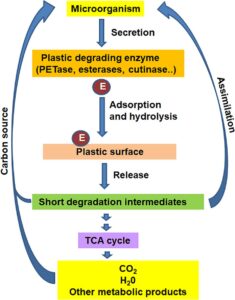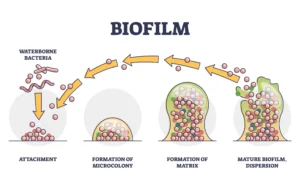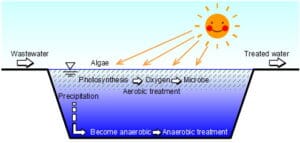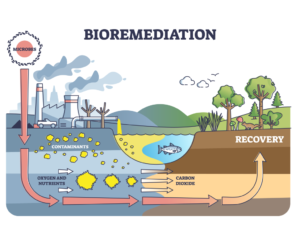Scopes of Environmental Biotechnology
Environmental biotechnology is a multidisciplinary field that leverages biological processes, organisms, and systems to address environmental challenges. It encompasses applications in pollution control, waste management, energy production, and sustainable development. The field plays a critical role in ensuring environmental protection and fostering sustainable solutions in response to global challenges like climate change, resource depletion, and pollution.

Major Scopes of Environmental Biotechnology
1. Wastewater Treatment
Environmental biotechnology provides efficient and sustainable solutions for wastewater treatment by employing microbial processes.
- Mechanism:
Microorganisms degrade organic pollutants and remove nutrients like nitrogen and phosphorus. These systems also eliminate pathogens and improve water quality. - Applications:
- Activated Sludge Process: Aerobic microorganisms metabolize organic matter in wastewater.
- Anaerobic Digestion: Organic pollutants are broken down anaerobically to produce biogas (methane).
- Constructed Wetlands: Utilize aquatic plants and associated microbes for natural wastewater treatment.
- Membrane Bioreactors (MBRs): Combine biological treatment and membrane filtration for high-quality effluent.
- Scope:
- Treatment of domestic and industrial wastewater.
- Nutrient recovery and energy production.
- Reuse of treated water in agriculture, industry, and municipal applications.
2. Solid Waste Management
Biotechnology offers effective solutions for reducing, reusing, and recycling solid waste through biological processes.
- Mechanism:
Microbial degradation of organic waste into compost or biogas. - Applications:
- Composting: Converts organic waste into nutrient-rich compost using aerobic microbes.
- Anaerobic Digestion: Produces biogas from organic waste in controlled anaerobic conditions.
- Bioreactor Landfills: Accelerate waste degradation and capture methane for energy use.
- Plastic Biodegradation: Development of microbes and enzymes that break down synthetic plastics.
- Scope:
- Reduction of landfill use and greenhouse gas emissions.
- Recovery of energy and nutrients from organic waste.
3. Bioremediation
Bioremediation is the use of biological systems to remove or neutralize contaminants from soil, water, and air.
- Types of Bioremediation:
- In-situ Bioremediation: Treats contaminated sites without excavation (e.g., venting, sparging).
- Ex-situ Bioremediation: Contaminated material is removed and treated offsite (e.g., biopiles, bioreactors).
- Applications:
- Cleanup of oil spills using oil-degrading microbes.
- Heavy metal removal using biosorbents like algae or fungal biomass.
- Pesticide degradation in agricultural runoff.
- Scope:
- Restoration of contaminated ecosystems.
- Effective treatment of hazardous and persistent pollutants.
4. Biodegradation
Biodegradation refers to the microbial breakdown of pollutants into less harmful compounds, enabling sustainable waste management.
- Applications:
- Degradation of industrial effluents such as dyes, phenols, and hydrocarbons.
- Development of microbes for breaking down persistent plastics and other xenobiotics.
- Scope:
- Reduction in the environmental impact of industrial and agricultural waste.
- Promotion of eco-friendly materials and processes.
5. Air Pollution Control
Biotechnology provides eco-friendly methods to mitigate air pollution.
- Mechanisms:
- Biofilters: Use microorganisms to degrade volatile organic compounds (VOCs) and odors in industrial emissions.
- Bioscrubbers: Capture and treat gaseous pollutants using microbial biofilms.
- Algal Systems: Sequester CO₂ from industrial flue gases and convert it into biomass.
- Applications:
- Reduction of pollutants like sulfur dioxide (SO₂), nitrogen oxides (NOx), and greenhouse gases.
- Scope:
- Sustainable air quality management.
- Development of renewable resources from captured emissions.
6. Energy Production (Bioenergy)
Environmental biotechnology enables the production of renewable energy from biological resources, reducing dependence on fossil fuels.
- Bioenergy Systems:
- Biogas Production: Methane production from organic waste via anaerobic digestion.
- Bioethanol and Biodiesel: Renewable fuels from crops, agricultural residues, or algae.
- Algal Biofuels: Use of algae to produce lipids that can be converted into biofuels.
- Applications:
- Energy recovery from agricultural waste, sewage, and municipal solid waste.
- Development of carbon-neutral fuels.
- Scope:
- Transition to a circular bioeconomy.
- Reduction of greenhouse gas emissions.
7. Sustainable Agriculture
Biotechnology contributes to sustainable agricultural practices by reducing environmental impacts.
- Applications:
- Biofertilizers: Use of nitrogen-fixing bacteria (e.g., Rhizobium, Azotobacter) and phosphate-solubilizing microbes.
- Biopesticides: Biological agents like Bacillus thuringiensis to control pests and diseases.
- Phytoremediation: Use of plants to extract or stabilize contaminants in soil.
- Scope:
- Improved soil fertility and crop productivity.
- Reduced dependence on synthetic fertilizers and pesticides.
8. Climate Change Mitigation
Environmental biotechnology plays a significant role in addressing climate change by reducing greenhouse gas emissions and developing adaptive solutions.
- Applications:
- Carbon capture and storage using algae and microbial systems.
- Reduction of methane emissions from landfills and livestock.
- Development of climate-resilient crops through genetic engineering.
- Scope:
- Reduction of global warming potential.
- Adaptation to extreme weather conditions.
9. Environmental Monitoring and Assessment
Biotechnology provides advanced tools for detecting and monitoring environmental pollutants.
- Applications:
- Biosensors: Devices that use biological components to detect heavy metals, pesticides, and toxins.
- Bioindicators: Organisms like lichens and algae to assess air and water quality.
- Scope:
- Real-time environmental monitoring.
- Early detection of contamination and assessment of ecosystem health.
10. Industrial Applications
Biotechnology enables the development of cleaner and more sustainable industrial processes.
- Applications:
- Use of enzymes in industries like textiles, paper, and pharmaceuticals to reduce chemical waste.
- Production of bioplastics and other biodegradable materials.
- Green manufacturing processes to minimize pollution.
- Scope:
- Promotion of eco-friendly industrial practices.
- Integration of circular economy principles.
Environmental biotechnology offers diverse applications across various sectors, from wastewater treatment to climate change mitigation. It integrates biological processes with technology to develop sustainable solutions for pressing environmental challenges. As the demand for eco-friendly and resource-efficient technologies grows, environmental biotechnology will play an increasingly crucial role in shaping a sustainable future.











